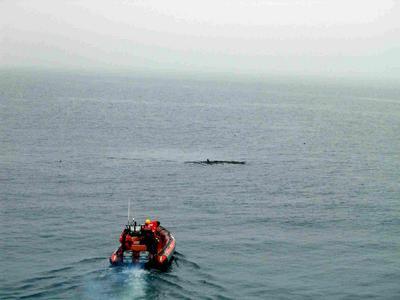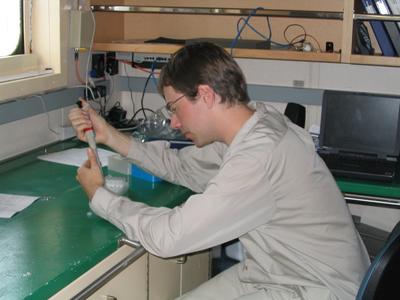
|
|
12 July, 2004
Peter van Hardenberg is a computer scientist and student at the University
of Victoria. His job on board ship is to collect samples for John Nelson, a
researcher at U. Victoria. Dr. Nelson studies copepods (a type of
zooplankton-small aquatic animals). He is studying the extent of different
populations of copepods in these waters. Peter's sampling involves the use
of bongo nets, a pair of large nets which are dropped and brought back to
the surface vertically to capture zooplankton. The nets take two samples
simultaneously so the two samples are comparable. One is then placed in
formaldehyde which preserves the appearance and color of the copepods. The
other sample is preserved in ethanol for later genetic analysis.
Peter is also doing flow cytometry, a process used to analyze bacteria and
viruses in the seawater. He takes seawater from the CTD bottles (pictures
of both the bongo nets and the CTD bottles will be with a future journal
entry) to preserve and bring back for later analysis. Since the bottles
collect water at varying depths, and Peter only wants the water with the
most chlorophyll (produced by the phytoplankton) he takes water from the
depth identified by fluorescence on the way down. Fluorescence is the
amount of glow in the water when a special light is used. I was amazed at
how coherent Peter was when I spoke with him since he had started his work
at 10 PM last night, finished around 7 this morning, and was still up when I
spoke to him after lunch at noon!
Just after I finished talking with Peter, we spotted something in front of
the ship. It was a large mass of seaweed with a seal resting on it.
Unfortunately, the seal had become entangled in a fish net and was
struggling to free itself. The crew launched a small boat and tried to get
near enough to cut the line. Despite their best efforts, the seal swam
away, still caught in the fishing line. The crew was hopeful that it might
be able to work the line off eventually, but the line was around the seal's
neck. If the seal is still growing, the line will eventually choke it.
Such problems are not uncommon. Many sea mammals and birds are caught each
year in fishing line and plastic six pack rings. Sea turtles sometimes die
from eating floating plastic bags which resemble jellyfish, a favorite food.
The events of today provided an unpleasant reminder of the profound impact
humans have on our environment.

You can just see the seal on the mat of seaweed. Unfortunately, the coast guard crew was unable to remove the fishing line from around its neck. --

Peter van Hardenberg at work in the ship's lab. --
Contact the TEA in the field at
.
If you cannot connect through your browser, copy the
TEA's e-mail address in the "To:" line of
your favorite e-mail package.
|
